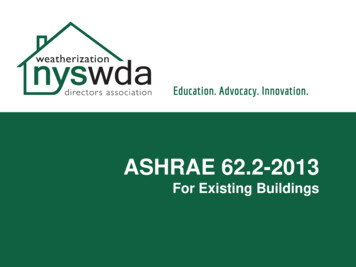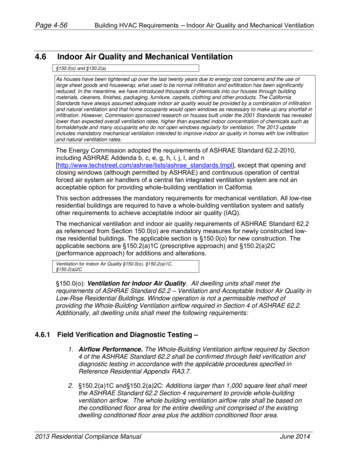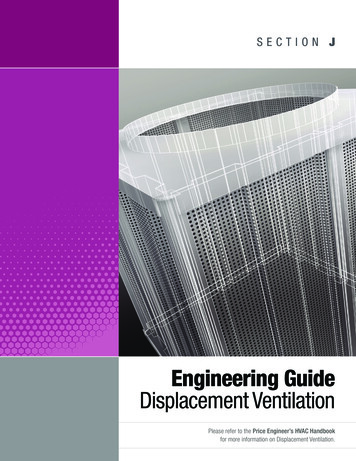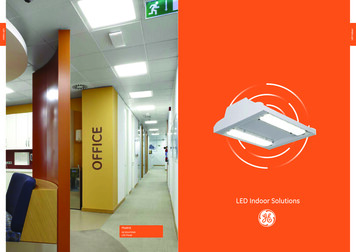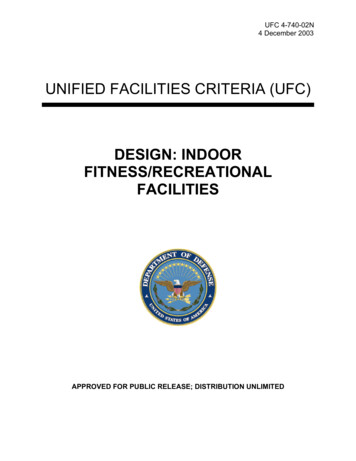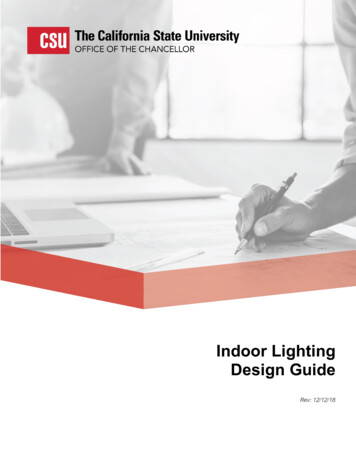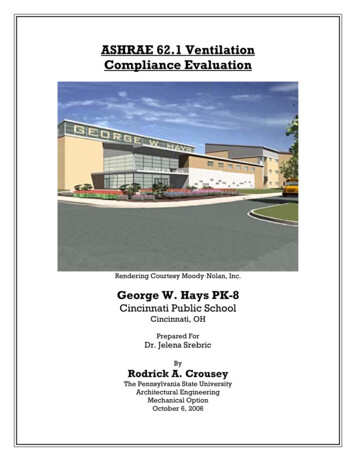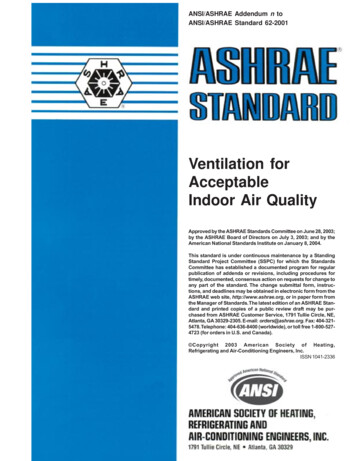
Transcription
ANSI/ASHRAE Addendum n toANSI/ASHRAE Standard 62-2001Ventilation forAcceptableIndoor Air QualityApproved by the ASHRAE Standards Committee on June 28, 2003;by the ASHRAE Board of Directors on July 3, 2003; and by theAmerican National Standards Institute on January 8, 2004.This standard is under continuous maintenance by a StandingStandard Project Committee (SSPC) for which the StandardsCommittee has established a documented program for regularpublication of addenda or revisions, including procedures fortimely, documented, consensus action on requests for change toany part of the standard. The change submittal form, instructions, and deadlines may be obtained in electronic form from theASHRAE web site, http://www.ashrae.org, or in paper form fromthe Manager of Standards. The latest edition of an ASHRAE Standard and printed copies of a public review draft may be purchased from ASHRAE Customer Service, 1791 Tullie Circle, NE,Atlanta, GA 30329-2305. E-mail: orders@ashrae.org. Fax: 404-3215478. Telephone: 404-636-8400 (worldwide), or toll free 1-800-5274723 (for orders in U.S. and Canada). Copyright 2003 American Society of Heating,Refrigerating and Air-Conditioning Engineers, Inc.ISSN 1041-2336
ASHRAE Standard Project Committee 62.1Cognizant TC: TC 4.3, Ventilation Requirements and InfiltrationSPLS Liaison: Fredrick H. KohlossAndrew K. Persily, Chair*David S. Bulter, Sr., Vice-Chair*Leon E. Alevantis*Michael BeatonLynn G. BellengerHoy R. Bohanon, Jr. *Dale J. CagwinJames L. Coggins*Elissa Feldman*Francis J. Fisher, Jr.*Francis Michael GalloScott Douglas Hanson*Roger L. HedrickThomas P. Houston*Eli P. Howard, III*Ralph T. JoeckelDonald G. Koch*Carl A. Marbery*Bernice A. Mattsson*John K. McFarlandChristopher O. Muller*Guillermo A. NavasJohn E. Osborn*R. Dean Rasmussen*Walter L. Raynaud*Lisa J. RogersRobert S. Rushing*Lawrence J. SchoenDennis A. StankeJan Sundell*Terry Lee SutherlandWayne ThomannJames A. TshudyDilip Y. Vyavaharkar*David R. WardenMichael W. Woodford**Denotes members of voting status when the document was approved for publicationASHRAE STANDARDS COMMITTEE 2002-2003Thomas E. Watson, ChairVan D. Baxter, Vice-ChairCharles G. ArnoldDean S. BorgesPaul W. CabotCharles W. Coward, Jr.Brian P. DoughertyHakim ElmahdyArthur D. HallstromMatt R. HarganRichard D. HermansStephen D. KennedyDavid E. KnebelFrederick H. KohlossWilliam J. LandmanMerle F. McBrideRoss D. MontgomeryCyrus H. NasseriDavor NovoselDennis A. StankeMichael H. TavaresSteven T. TaylorDavid R. TreeTerry E. Townsend, COMaureen Grasso, ExOClaire B. Ramspeck, Manager of StandardsSPECIAL NOTEThis American National Standard (ANS) is a national voluntary consensus standard developed under the auspices of the AmericanSociety of Heating, Refrigerating and Air-Conditioning Engineers (ASHRAE). Consensus is defined by the American National StandardsInstitute (ANSI), of which ASHRAE is a member and which has approved this standard as an ANS, as “substantial agreement reachedby directly and materially affected interest categories. This signifies the concurrence of more than a simple majority, but not necessarilyunanimity. Consensus requires that all views and objections be considered, and that an effort be made toward their resolution.”Compliance with this standard is voluntary until and unless a legal jurisdiction makes compliance mandatory through legislation.ASHRAE obtains consensus through participation of its national and international members, associated societies, and publicreview.ASHRAE Standards are prepared by a Project Committee appointed specifically for the purpose of writing the Standard. TheProject Committee Chair and Vice-Chair must be members of ASHRAE; while other committee members may or may not be ASHRAEmembers, all must be technically qualified in the subject area of the Standard. Every effort is made to balance the concerned interestson all Project Committees.The Manager of Standards of ASHRAE should be contacted for:a. interpretation of the contents of this Standard,b. participation in the next review of the Standard,c. offering constructive criticism for improving the Standard,d. permission to reprint portions of the Standard.DISCLAIMERASHRAE uses its best efforts to promulgate Standards and Guidelines for the benefit of the public in light of availableinformation and accepted industry practices. However, ASHRAE does not guarantee, certify, or assure the safety orperformance of any products, components, or systems tested, installed, or operated in accordance with ASHRAE’s Standardsor Guidelines or that any tests conducted under its Standards or Guidelines will be nonhazardous or free from risk.ASHRAE INDUSTRIAL ADVERTISING POLICY ON STANDARDSASHRAE Standards and Guidelines are established to assist industry and the public by offering a uniform method oftesting for rating purposes, by suggesting safe practices in designing and installing equipment, by providing proper definitionsof this equipment, and by providing other information that may serve to guide the industry. The creation of ASHRAE Standardsand Guidelines is determined by the need for them, and conformance to them is completely voluntary.In referring to this Standard or Guideline and in marking of equipment and in advertising, no claim shall be made, eitherstated or implied, that the product has been approved by ASHRAE.
(This foreword is not part of this standard. It is merelyinformative and does not contain requirements necessaryfor conformance to the standard. It has not been processed according to the ANSI requirements for a standard and may contain material that has not been subjectto public review or a consensus process.)Foreword to Addendum 62nThis addendum revises the Ventilation Rate Procedurecurrently contained in Section 6.1 of ANSI/ASHRAE Standard62-2001. This revision was developed as part of the effort toconvert the entire standard to mandatory, enforceable language suitable for adoption into building codes and to reflectnew technical information that has become available since thecurrent Ventilation Rate Procedure was prepared in the mid1980s.The Ventilation Rate Procedure in Standard 62-2001 isessentially identical to the version in the 1989 standard andcontains a number of requirements that run counter to the current objectives of minimum requirements and mandatory,enforceable language. For example, the current standard specifies outdoor air requirements in the “breathing zone,” whichare very difficult to actually measure and therefore to enforce.It also requires one to account for air mixing in ventilatedspaces when determining outdoor air rates but provides nospecific calculation approach for doing so. Standard 62 alsorequires the use of the so-called “multiple spaces” equation toadjust outdoor air rates for recirculating systems that servemore than one room. However, this equation is seldom used bydesigners (possibly due to its perceived complexity) and, aspresented in the current standard, does not apply to manycommon system types.The revision in this addendum addresses these issuesrelated to the objective of code-intended language in a numberof ways. It specifies the determination of design ventilationrates that can be easily measured so that compliance can beverified, both by review of the design documents and by fieldmeasurement. It does this by relating the ventilation requirements in the breathing zone to the outdoor air intake rate atthe air-handling system, a quantity that is more readily measured using standard airflow measurement techniques as specified in ASHRAE Standard 111. In this revision, room mixingis addressed explicitly in the calculation of ventilation rates,with default values for the air change effectiveness provided tofacilitate the application of this adjustment. In addition, multiple space calculations have been greatly simplified for thebulk of design applications, with a more detailed approachavailable for those who choose to use it.Regarding the ventilation requirements themselves, mostof them have been decreased relative to the 1989/2001 versionof the standard. However, with the explicit requirement toaccount for room mixing and ventilation system efficiency, thetotal outdoor airflow rate at the air intake will not changemuch in most systems. The most significant changes in theventilation requirements occur in densely occupied spaces,such as conference rooms and auditoria, requirements thathad been strongly criticized as being much higher thanAddendum n to ANSI/ASHRAE STANDARD 62-2001needed. Furthermore, since the standard is now focused onminimum requirements, the ventilation rate requirements arebased on that focus as opposed to the 1989 standard, whichwas not. Also, in recognition of the fact that indoor air pollutants are generated by both building occupants (and theiractivities) as well as by the contents of a building, the ventilation requirements include both a people component (to dilutecontaminants from people and their activities) and an areacomponent (to dilute contaminants from non-occupant-relatedsources that are more related to floor area than the number ofpeople). The ventilation requirements for a particular spacebased on people and on floor area are then added together todetermine the total ventilation requirement for a space. Whileacknowledging that the “additivity” approach does not applyto all aspects of indoor air quality, the committee believes thatadditivity is the predominant effect when considering multiplecontaminant sources that impact occupant perception withrespect to odor and irritation. While important questionsremain regarding additivity, the majority of research data support its use in this context.The first public review of addendum 62n occurred in 1999and produced about 70 unique comments. Of these, about halfcalled for increased ventilation rates, while a smaller numbersuggested further decreases. About 10% of the commentsaddressed the issue of complexity, and these were evenly splitbetween complaints about too much complexity and requestsfor more detail. About one-third commented on the additivemethodology for combining the ventilation requirementsbased on the number of people with the requirements based onfloor area, but the committee retained this approach based onthe principles discussed above and the ability to explicitlyadjust ventilation rates based on occupant density. In responseto many of the public review comments, a full second publicdraft was developed and issued for comment. In this draft,some of the ventilation requirements were increased (mostnotably in educational buildings) relative to the first publicreview draft. A number of changes were also made to addressthe concerns of complexity, including the removal of a requirement for minimum supply airflow rates and a number ofchanges in the language and notation.The second public review resulted in about 80 uniquecomments, most of which addressed the same issues identifiedin the first public review. As a result, a limited number ofchanges were issued for a third public review, including arevised definition of “zone,” simplified approaches for determining outdoor air intake rates for single-zone and 100% outdoor air systems, revision of the tables of default values ofzone and system ventilation efficiencies, and a revision of thenormative appendix that presents a more detailed methodology for determining system ventilation efficiencies. This moredetailed methodology is an alternative that is not required forcommon system types.Finally, to make application of the calculation methodseasier for users of the standard, a spreadsheet called 62nVRP.xls was developed. It is available for free download at theASHRAE web site (currently under the SSPC62.1 directory atftp.ashrae.org).1
Addendum 62nIn Section 3, “Definitions,” change the name of the term“occupied zone” and update the reference as follows:occupied zonebreathing zone: the region within an occupiedspace between planes 3 and 72 in. (75 and 1800 mm) abovethe floor and more than 2 ft (600 mm) from the walls or fixedair-conditioning equipment (see ASHRAE Standard 5519921981, Reference 1).Add the following definition to Section 3:zone: One occupied space or several occupied spaces withsimilar occupancy category (see Table 6.1), occupant density,zone air distribution effectiveness (see Section 6.2.1.2), andzone primary airflow (see Section 6.2.4.1) per unit area. Note:A ventilation zone is not necessarily an independent thermalcontrol zone; however, spaces that can be combined for loadcalculations can often be combined into a single zone forventilation calculations.Delete the current Section 6.1, Ventilation Rate Procedure (currently numbered as Section 6.2 in accordance withaddendum 62i, approved in 2002) and replace it with thefollowing:SKOVentilation Rate ProcedureThe design outdoor air intake flow (Vot) for a ventilationsystem shall be determined in accordance with Sections 6.2.1through 6.2.5.Note: Additional explanation of terms used below iscontained in Appendix G, along with a ventilation systemschematic (Figure G-1).SKOKN Zone Calculations. Zone parameters shall be determined in accordance with Sections 6.2.1.1 through 6.2.1.3.Note: In some cases it is acceptable to determine theseparameters for only selected zones as outlined in Appendix G.SKOKNKN Breathing Zone Outdoor Airflow. The designoutdoor airflow required in the breathing zone of the occupiable space or spaces in a zone, i.e., the breathing zone outdoorairflow (Vbz), shall be determined in accordance with Equation 6-1.Vbz RpPz RaAz(6-1)where:Az zone floor area: the net occupiable floor area of thezone m2, (ft2).Pz zone population: the largest number of peopleexpected to occupy the zone during typical usage. Ifthe number of people expected to occupy the zonefluctuates, Pz may be estimated based on averagingapproaches described in Section 6.2.5.2. Note: If Pzcannot be accurately predicted during design, it maybe an estimated value based on the zone floor area andthe default occupant density listed in Table 6.1.Rp outdoor airflow rate required per person as determinedfrom Table 6.1. Note: These values are based onadapted occupants.Ra outdoor airflow rate required per unit area asdetermined from Table 6.1.2Note: Equation 6.1 is the means of accounting for peoplerelated sources and area-related sources for determining theoutdoor air required at the breathing zone. The use of Equation6-1 in the context of this standard does not necessarily implythat simple addition of sources can be applied to any otheraspect of indoor air quality.SKOKNKO Zone Air Distribution Effectiveness. The zoneair distribution effectiveness (Ez) shall be determined usingTable 6.2.SKOKNKP Zone Outdoor Airflow. The design zone outdoor airflow (Voz), i.e., the outdoor airflow that must be provided to the zone by the supply air distribution system, shallbe determined in accordance with Equation 6-2.Voz Vbz/Ez(6-2)SKOKO Single-Zone Systems. When one air handler supplies a mixture of outdoor air and recirculated air to only onezone, the outdoor air intake flow (Vot) shall be determined inaccordance with Equation 6-3.Vot Voz(6-3)SKOKP 100% Outdoor Air Systems. When one air handlersupplies only outdoor air to one or more zones, the outdoorair intake flow (Vot) shall be determined in accordance withEquation 6-4.Vot ΣVoz(6-4)SKOKQ Multiple-Zone Recirculating Systems. When oneair handler supplies a mixture of outdoor air and recirculatedreturn air to more than one zone, the outdoor air intake flow(Vot) shall be determined in accordance with Sections 6.2.4.1through 6.2.4.4.SKOKQKN Primary Outdoor Air Fraction. When Table6.3 is used to determine system ventilation efficiency, thezone primary outdoor air fraction (Zp) shall be determined inaccordance with Equation 6-5.Zp Voz/Vpz(6-5)where Vpz is the zone primary airflow, i.e., the primary airflowto the zone from the air handler including outdoor air andrecirculated return air. Note: For VAV systems, Vpz is theminimum expected primary airflow.SKOKQKO System Ventilation Efficiency. The system ventilation efficiency (Ev) shall be determined using Table 6.3 orAppendix G.SKOKQKP Uncorrected Outdoor Air Intake. The designuncorrected outdoor air intake (Vou) shall be determined inaccordance with Equation 6-6.Vou D Σall zones RpPz Σall zones RaAz(6-6)The occupant diversity, D, may be used to account forvariations in occupancy within the zones served by the system.The occupancy diversity is defined asD Ps/Σall zones Pz(6-7)where the system population (Ps) is the total population in thearea served by the system. Alternative methods may be usedto account for population diversity when calculating Vou,provided the resulting value is no less than that determined byEquation 6-6.Note: The uncorrected outdoor air intake (Vou) isadjusted for diversity but uncorrected for ventilation efficiency.Addendum n to ANSI/ASHRAE STANDARD 62-2001
TABLE 6.1Minimum Ventilation Rates In Breathing Zone(This table is not valid in isolation; it must be used in conjunction with the accompanying notes.)Default ValuesPeople Outdoor Air RateRPcfm/personL/s personArea Outdoor Air RateRAcfm/ft2Occupant Density (see Note 4)L/s m2Occupancy CategoryNotesCombined Outdoor Air Rate (seeNote 5)#/1000 ft2(#/100 m2)cfm/personL/s personCorrectional FacilitiesCell52.50.120.625104.9Day room52.50.060.33073.5Guard e (through age 4)1050.180.925178.6Classrooms (ages 5-8)1050.120.625157.4Booking/waitingEducational FacilitiesClassrooms (age 9 plus)1050.120.635136.7Lecture classroom7.53.80.060.36584.3Lecture hall (fixed seats)7.53.80.060.315084.0Art classroom105.00.180.920199.5Science laboratories105.00.180.925178.6Wood/metal shop1050.180.920199.5Computer lab1050.120.625157.4Media 60.335125.9Multi-use assembly7.53.80.060.310084.1Restaurant dining rooms7.53.80.180.970105.1Cafeteria/fast food dining7.53.80.180.910094.7Bars, cocktail .060.35063.1Corridors--0.060.3Storage rooms--0.120.652.50.060.310115.5AFood and Beverage ServiceGeneralB-Hotels, Motels, Resorts, DormitoriesBedroom/living roomBarracks sleeping 0.312062.8Office space52.50.060.35178.5Reception areas52.50.060.33073.5Telephone/data entry52.50.060.36063.0Main entry lobbies52.50.060.310115.5Bank vaults/safe deposit52.50.060.35178.5Computer (not printing)52.50.060.342010.0Pharmacy (prep. area)52.50.180.9102311.5Photo purpose assemblyOffice BuildingsMiscellaneous spacesAddendum n to ANSI/ASHRAE STANDARD 62-20013
TABLE 6.1(Continued)Minimum Ventilation Rates In Breathing Zone(This table is not valid in isolation; it must be used in conjunction with the accompanying notes.)Default ValuesPeople Outdoor Air RateRPcfm/personL/s personArea Outdoor Air RateRAcfm/ft2Occupant Density (see Note 4)L/s m2Occupancy CategoryNotes#/1000 ft2(#/100 m2)cfm/personL/s m seating area5.02.50.060.315052.7Places of religious 7062.9Legislative 0178.5Lobbies5.02.50.060.315052.7Museums s7.53.80.060.34094.6Sales (except as below)7.53.80.120.615167.8Mall common areas7.53.80.060.34094.6Barber tation waitingWarehousesBCombined Outdoor Air Rate (seeNote 5)100B-Public Assembly SpacesRetailBeauty and nail salons20100.120.6252512.4Pet shops (animal 38157.6Coin-operated 7.53.80.060.315084.0Sports and EntertainmentSports arena (play area)Gym, stadium (play area)Spectator areasSwimming (pool and deck)--0.482.4Disco/dance floors20100.060.3C1002110.3Health club/aerobics room20100.060.3402210.8Health club/weight rooms20100.060.3102613.0Bowling alley (seating)105.00.120.640136.5Gambling casinos7.53.80.180.912094.6Game arcades7.53.80.180.920178.3Stages, studios105.00.060.370115.4DGENERAL NOTES FOR TABLE 6.11 Related Requirements: The rates in this table are based on all other applicable requirements of this standard being met.2 Smoking: This table applies to no-smoking areas. Rates for smoking-permitted spaces must be determined using other methods.3 Air Density: Volumetric airflow rates are based on an air density of 1.2 kgda/m3 (0.075 lbda/ft3), which corresponds to dry air at a barometric pressure of 101.3 kPa (1 atm) andan air temperature of 21 C (70 F). Rates may be adjusted for actual density, but such adjustment is not required for compliance with this standard.4 Default Occupant Density: The default occupant density shall be used when actual occupant density is not known.5 Default Combined Outdoor Air Rate (per person): This rate is based on the default occupant density.6 Unlisted Occupancies: If the occupancy category for a proposed space or zone is not listed, the requirements for the listed occupancy category that is most similar in terms ofoccupant density, activities, and building construction shall be used.7 Residential facilities, Health care facilities, and Vehicles: Rates shall be determined in accordance with Appendix E.ITEM-SPECIFIC NOTES FOR TABLE 6.1A For high school and college libraries, use values shown for Public Spaces – Libraries.B Rate may not be sufficient when stored materials include those having potentially harmful emissions.C Rate does not allow for humidity control. Additional ventilation or dehumidification may be required to remove moisture.D Rate does not include special exhaust for stage effects, e.g., dry ice vapors, smoke.4Addendum n to ANSI/ASHRAE STANDARD 62-2001
TABLE 6.2Zone Air Distribution EffectivenessTABLE 6.3System Ventilation EfficiencyEzMax (ZP)EVCeiling supply of cool air1.0 0.250.9Ceiling supply of warm air and floor return1.0 0.350.8Ceiling supply of warm air at least 8 C (15 F) abovespace temperature and ceiling return.0.8 0.450.7 0.550.6Ceiling supply of warm air less than 8 C (15 F) abovespace temperature and ceiling return provided that the0.8 m/s (150 fpm) supply air jet reaches to within 1.4 m(4.5 ft) of floor level. Note: For lower velocity supply air,Ez 0.8.1.0 0.55Use Appendix GFloor supply of cool air and ceiling return provided thatthe 0.8 m/s (150 fpm) supply jet reaches at least 1.4 m(4.5 ft) above the floor. Note: Most underfloor air distribution systems comply with this proviso.1.0Floor supply of cool air and ceiling return, provided lowvelocity displacement ventilation achieves unidirectionalflow and thermal stratification1.2Floor supply of warm air and floor return1.0Floor supply of warm air and ceiling return0.7Makeup supply drawn in on the opposite side of theroom from the exhaust and/or return0.8Makeup supply drawn in near to the exhaust and/orreturn location0.5Air Distribution ConfigurationNotes for Table 6.21. “Cool air” is air cooler than space temperature.2. “Warm air” is air warmer than space temperature.3. “Ceiling” includes any point above the breathing zone.4. “Floor” includes any point below the breathing zone.5. As an alternative to using the above values, Ez may be regarded as equal to airchange effectiveness determined in accordance with ASHRAE Standard 129 forall air distribution configurations except unidirectional flow.SKOKQKQ Outdoor Air Intake. The design outdoor airintake flow (Vot) shall be determined in accordance withEquation 6-8.Vot Vou/EvSKOKR(6-8)Design for Varying Operating Conditions.SKOKRKN Variable Load Conditions. Ventilation systemsshall be designed to be capable of providing the required ventilation rates in the breathing zone whenever the zones servedby the system are occupied, including all full- and part-loadconditions.SKOKRKO Short-Term Conditions. If it is known thatpeak occupancy will be of short duration and/or ventilationwill be varied or interrupted for a short period of time, thedesign may be based on the average conditions over a timeperiod T determined by Equation 6-9:T 3 v / Vbz(6-9a) IPT 50 v / Vbz(6-9b) SIAddendum n to ANSI/ASHRAE STANDARD 62-2001Notes for Table 6.31. “Max Zp” refers to the largest value of Zp, calculated using Equation 6-5, among allthe zones served by the system.2. For values of Zp between 0.15 and 0.55, one may determine the correspondingvalue of Ev by interpolating the values in the table.3. The values of Ev in this table are based on a 0.15 average outdoor air fraction forthe system (i.e., the ratio of the uncorrected outdoor air intake Vou to the total zoneprimary airflow for all the zones served by the air handler). For systems with highervalues of the average outdoor air fraction, this table may result in unrealistically lowvalues of Ev and the use of Appendix G may yield more practical results.where:T averaging time period, (min)v the volume of the zone for which averaging is beingapplied, ft3 (m3).Vbz the breathing zone outdoor airflow calculated usingEquation 6-1 and the design value of the zonepopulation Pz, cfm (L/s).Acceptable design adjustments based on this optionalprovision include the following:1.Zones with fluctuating occupancy: The zone population(Pz) may be averaged over time T.2.Zones with intermittent interruption of supply air: The average outdoor airflow supplied to the breathing zone overtime T shall be no less than the breathing zone outdoorairflow (Vbz) calculated using Equation 6-1.3.Systems with intermittent closure of the outdoor air intake:The average outdoor air intake over time T shall be no lessthan the minimum outdoor air intake (Vot) calculated usingEquation 6-2, 6-3, or 6-4 as appropriate.SKOKS Dynamic Reset. The system may be designed toreset the design outdoor air intake flow (Vot) and/or space orzone airflow as operating conditions change. These conditions include but are not limited to:1.Variations in occupancy or ventilation airflow in one ormore individual zones for which ventilation airflowrequirements will be reset. Note: Examples of measures forestimating such variations include: occupancy scheduledby time-of-day, a direct count of occupants, or an estimateof occupancy or ventilation rate per person using occupancy sensors such as those based on indoor CO2 concentrations.2.Variations in the efficiency with which outdoor air isdistributed to the occupants under different ventilationsystem airflows and temperatures.3.A higher fraction of outdoor air in the air supply due tointake of additional outdoor air for free cooling or exhaustair makeup.5
7TABLE 6.4Minimum Exhaust RatesOccupancy CategoryExhaust ExhaustExhaust ExhaustRateRateRateRatecfm/unit cfm/ft2 Notes L/s-unit L/s-m2Art classrooms-0.70Auto repair rooms-1.50-3.5-7.5Barber shop-0.50-2.5Beauty and nail salons-0.60-3.0Cell with chen - commercial-0.70--3.5Kitchenettes-0.30--1.5Locker rooms-0.50-2.5Locker/dressing rooms-0.25-1.25Parking garages-0.75--3.7Janitor, trash, recycle-1.00-5.0Pet shops (animal areas)-0.90-4.5Copy, printing rooms-0.50-2.5Science lab classrooms-1.00-5.0ABCToilets - public50/70-D25/35-Toilet - private25/50-E12.5/25--0.50-2.5Woodwork shop/classroomNotes For Table 6.4A—Stands where engines are run shall have exhaust systems that directly connect tothe engine exhaust and prevent escape of fumes.B—When combustion equipment is intended to be used on the playing surface, additional dilution ventilation and/or source control shall be provided.C—Exhaust not required if two or more sides comprise walls that are at least 50% opento the outside.D—Rate is per water closet and/or urinal. Provide the higher rate where periods ofheavy use are expected to occur, e.g., toilets in theaters, schools, and sports facilities.The lower rate may be used where use is intermittent.E—Rate is for a toilet room intended to be occupied by one person at a time. For continuous system operation during normal hours of use, the lower rate may be used.Otherwise use the higher rate.SKOKTExhaust Ventilation. Exhaust airflow shall be pro-vided in accordance with the requirements in Table 6.4.Exhaust makeup air may be any combination of outdoor air,recirculated air, and transfer air.Delete the following references from Section 9. [Textcontaining these references has been deleted from the standard.]6ACGIH. 1986. Industrial Ventilation--A Manual of Recommended Practice. 1986 ed. American Conference ofGovernmental Industrial Hygienists, Committee onIndustrial Ventilation, P.O. Box 16153, Lansing, MI48901.20 NIOSH Manual of Analytical Methods, 2d Ed., April1977. Pub. No. 77-157, 4 vols. Cincinnati: NationalInstitute for Occupational Safety and Health.21NIOSH Manual Sampling Data Sheets with Suppl., Pubs.Nos. 77-159 and 78-189, March, 1977 and August,1978. Note: The Clearinghouse for Occupational Safetyand Health of NIOSH, 4676 Columbia Parkway, Cincinnati, OH 45226, is willing to fill occasional requests forseparate sheets of the information on individual air contaminants from these publications on request. NationalInstitute for Occupational Safety and Health, Cincinnati.22ACGIH Threshold Limit Values and Biological ExposureIndices for 1986-87. American Conference of Governmental Industrial Hygienists, 6500 Glenway, Bldg. D-7,Cincinnati, OH 45211-4438, 1987.23Standards Association of Australia. 1980. AustralianStandard AS1668 Part 2, 1980 - Ventilation Requirements, Clause 3.5.2, Appendix A&B. Standards Association of Australia, Standards House, 80 Arthur St.,North Sydney, NSW, 2060. 1980.24Kowalczewski, J.J. 1973. “Quality of air in air conditioning.” AIRAH, Feb. Australian Institute of Refrigeration,Air Conditioning and Heating.25Janssen, J.E., T. Hill, J.E. Woods, and E.A.B. Maldonado.1982. “Ventilation for control of indoor air quality: Acase st
2 Addendum n to ANSI/ASHRAE STANDARD 62-2001 Addendum 62n In Section 3, “Definitions,” change the name of the term “occupied zone” and update the reference as follows: occupied zonebreathing zone: the region within an occupied
